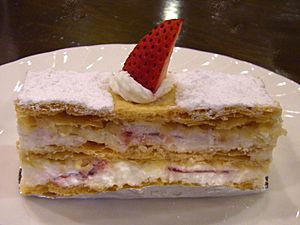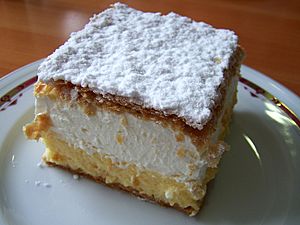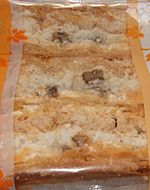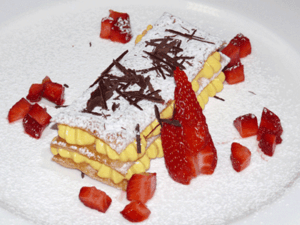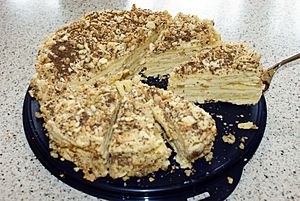- This page was last modified on 17 October 2025, at 10:18. Suggest an edit.
Mille-feuille facts for kids
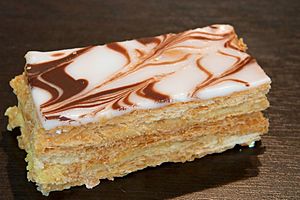
Mille-feuille
|
|
| Alternative names | gâteau de mille-feuilles, vanilla slice or custard slice, Napoleon pastry |
|---|---|
| Type | Pastry, cake |
| Course | Dessert |
| Main ingredients | Puff pastry, custard, powdered sugar |
| Variations | Frangipane, whipped cream |
The mille-feuille is a yummy pastry. Its name means "thousand-sheets" in French. People also call it a vanilla slice or custard slice. It is a bit like a Napoleon pastry. No one knows exactly where it came from. But a chef named Marie-Antoine Carême helped make it better.
A traditional mille-feuille has three layers of puff pastry. This is a special dough that puffs up when baked. Between these layers are two layers of creamy pastry cream. The top layer often has cream and chocolate drizzled on it. Sometimes it has cocoa, pastry crumbs, or sliced almonds. Other times, the top is covered with icing or fondant. This icing can have white and brown (chocolate) stripes. These stripes are often "combed" to make a cool pattern.
Contents
History of the Mille-feuille
The idea for mille-feuille has been around for a long time. Recipes with similar parts were in cookbooks way back in the 1500s. But we don't know the exact story of how the mille-feuille started.
Some old cookbooks from the 1600s and 1700s show recipes like the mille-feuille. These were early versions of what we now call layer cakes.
The name 'mille-feuille' first appeared in a cookbook in 1733. A French chef named Vincent La Chapelle wrote it in English. In the 1700s, mille-feuille was filled with jam, not cream.
In France, the name mille-feuille was first seen in a cookbook in 1749. It was written by a chef named Menon. He described making five thin layers of puff pastry. He said to put jam between each layer. Then, cover the whole cake with white icing. You could even decorate it with red currant jelly or candied lemon.
Later, in the 1800s, during the time of Napoleon Bonaparte, fancy bakeries in Paris sold this cake. Most recipes still used jam. But one recipe from 1876 used Bavarian cream instead.
Some people think the way the mille-feuille is put together came from Szeged, Hungary. There, a similar cake with caramel on top is called 'Szegediner Torte'.
What's in a Mille-feuille?
A traditional mille-feuille has three layers of light, flaky puff pastry. It also has two layers of creamy pastry cream. The very top layer is usually dusted with powdered sugar.
Sometimes, the top is covered with icing. This icing can have white and brown (chocolate) stripes. These stripes are often "combed" to make a cool design.
Today, you can even find savory mille-feuille! These have fillings like cheese and spinach. They are not sweet at all.
Often, fruits like strawberries and raspberries are added between the layers.
Different Kinds of Mille-feuille
Long ago, this pastry was called gâteau de mille-feuilles. This means "cake of a thousand sheets." This name comes from how many layers of pastry it has. If you make puff pastry the traditional way, it can have 729 layers! Some modern recipes can even have over 2,000 layers.
Some people believe the Napoleon pastry is a type of mille-feuille. Napoleon pastry often uses frangipane (an almond cream) instead of custard.
Australia
In Australia, a similar pastry is called a custard slice or vanilla slice. It's sometimes jokingly called a 'snot block'. It uses a firm custard, and often has passionfruit icing on top. A "French Vanilla slice" is more like the original mille-feuille. In New Zealand, it's known as a 'custard slice', 'custard square', or 'vanilla slice'. With passion-fruit icing, it's a 'passion-fruit slice'.
Balkan Countries
In countries like Serbia, Bosnia and Herzegovina, Slovenia, and Croatia, there's a similar dessert. It's called krempita or kremna rezina. In Slovakia, it's called krémeš.
Belgium and the Netherlands
In Belgium and the Netherlands, the equivalent pastry is the tompouce or tompoes. In the Netherlands, it's very famous. It almost always has two pastry layers and pink icing. But for national holidays, the icing is orange! A cartoon character, Tom Puss, is named after this pastry.

Tompouce on King's Day in the Netherlands
Canada
In Canada, mille-feuille is often called gâteaux Napoléon or 'Napoleon slice'. It can have custard, whipped cream, or both. Almond paste is a common filling. Some French Canadians make it with graham crackers instead of puff pastry, and pudding instead of custard.
Germany and Austria
In the German-speaking part of Switzerland and in Austria, it's called Cremeschnitte. In Israel, it's known as kremshnit.
Greece
In Greece, the pastry is called μιλφέιγ. This is just the Greek way of saying 'mille-feuille'. It has cream between the layers. The top is covered with a special whipped cream called Chantilly cream.
Hong Kong and China
In Hong Kong, the 拿破侖 (Napoleon) has buttercream, meringue, and walnuts. In Mainland China, a similar pastry called Napoleon (Chinese: 拿破侖) or Chinese: 法式千層酥 (French thousand-layer pastry) is also popular. It usually has puff pastry on the top and bottom. The middle is often sponge cake and a creamy filling.
Hungary
In Hungary, it's called krémes. One type, the francia krémes (French Napoleon), has whipped cream and caramel on top.
Italy
In Italy, it's known as mille foglie. It has similar fillings. There's also a savory Italian version. It has puff pastry filled with spinach, cheese, or pesto. Sometimes, the Italian version also has layers of sponge cake along with the puff pastry.
Iran
In Iran, the pastry is called شيرينى ناپلئونى. This means "Napoleonic sweet pastry." It has thin puff pastry and is often topped with powdered sugar.
Lithuania
In Lithuania, the Napoleon or Napoleonas is like the Russian version. Lithuanians sometimes add fruit filling, like apricots. It's often eaten at weddings or celebrations.
North Africa
In Tunisia, Morocco, and Algeria, mille-feuille are eaten often. They are known by their French name.
Philippines
In the Philippines, they are called napoleones. They have two or three layers with pastry cream or white custard. They are topped with a sugar glaze. This pastry is a popular treat on Negros Island.
Poland
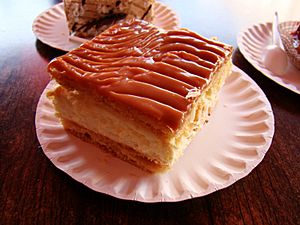
Polish Napoleonka
In Poland, the local version is called napoleonka or kremówka. It has two pastry layers with a thick cream layer in between. The whole pastry is covered with powdered sugar.
Russia
Russian books mention a cake called 'Napoleon' (Russian: Наполеон) since the early 1800s. It became very popular after Russia won against Napoleon in 1812. During the celebrations, people sold triangle-shaped pastries. These looked like Napoleon's hat. The many layers of the cake stood for Napoleon's large army. The crumbs on top were like the snow of Russia that helped defeat him. Today, the Napoleon cake is still very popular in Russia. It usually has more layers than the French one, but is the same height.
South Africa
In South Africa and Zimbabwe, it's called a 'custard slice'.
Spain
In Spain, the milhojas has thin, crispy puff pastry. They can be much taller than just three layers, sometimes reaching up to half a foot high!
Sweden
In Sweden and Finland, the Napoleonbakelse (Napoleon pastry) is a mille-feuille. It's filled with whipped cream, custard, and jam. The top has icing and currant jelly. In Denmark, it's called napoleonskage, and in Norway, napoleonskake. Both mean 'Napoleon cake'.
United Kingdom
In the United Kingdom, this pastry is usually called a 'vanilla slice', 'cream slice', or 'custard slice'. Sometimes, it's called mille-feuille or 'Napoleon' on store-bought items. In the UK, it often has only two pastry slices with one thick layer of filling.
Other Variations
In Latin America, milhojas often has many layers of puff pastry. These are filled with dulce de leche (a sweet caramel cream) and topped with powdered sugar. A version from Colombia has dulce de leche and melted bocadillo (guava paste) between the layers. It's topped with whipped cream and coconut flakes.


